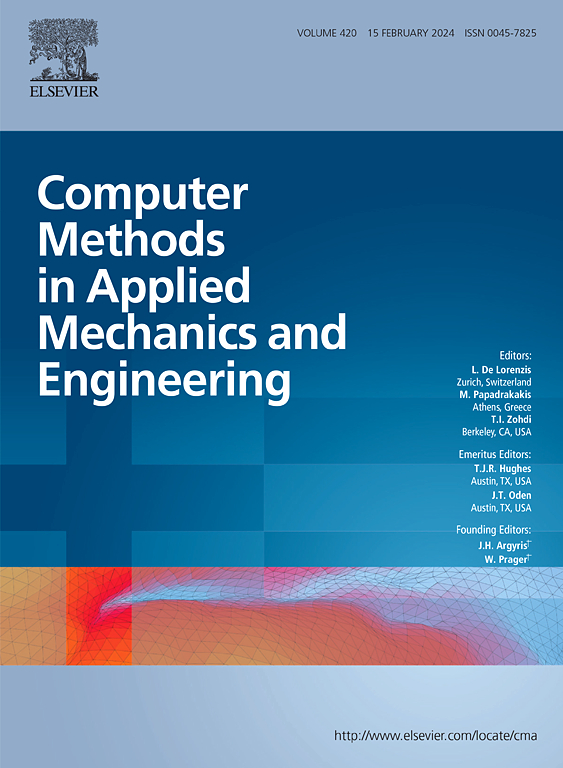基于黎曼几何的细胞超材料周动力学计算均匀化方法
IF 6.9
1区 工程技术
Q1 ENGINEERING, MULTIDISCIPLINARY
Computer Methods in Applied Mechanics and Engineering
Pub Date : 2024-12-30
DOI:10.1016/j.cma.2024.117714
引用次数: 0
摘要
在细胞超材料的周动力学框架下,提出了一种新的基于黎曼几何的双尺度计算均匀化技术。这里的想法是设想在宏观物体的参考构型中有两个无限小距离的物质点,它们在微观结构中相距有限距离。由于微观结构中存在孔洞或缺陷,这两点之间的最短路径不是直线,而是测地线曲线。这清楚地表明,在宏观结构中,这两点之间的无限小距离不能用欧几里得几何来计算。提出了宏观结构的内在几何是黎曼的,并提出了一个相关的对称度量张量,设计了一个基于搜索水平的程序来计算度量张量的分量。借鉴计算机科学图论的思想,我们提出了一种基于Dijkstra算法的新方法,将离散PD域视为无向加权图,计算两个粒子之间的最短距离。提出了一种基于双尺度PD的均匀化计算方法,概述了材料有效性能的计算过程。采用牛顿-拉夫逊法和预测校正法分别计算了结构在静、动荷载作用下的响应。首先,用解析解、ANSYS有限元分析结果和实验结果验证了PD模型的解。采用所提出的均匀化方法得到的宏观结构在PD框架下的响应用有限元方法进行了验证。在此基础上,对不同形态的宏观结构在静、动荷载作用下进行了分析。通过比较宏观结构的响应,研究了不同的搜索视界对度量张量系数的影响。动态裂纹扩展模拟表明了在宏观结构中考虑黎曼几何的重要性。本文章由计算机程序翻译,如有差异,请以英文原文为准。
Riemannian geometry based peridynamics computational homogenization method for cellular metamaterials
A novel Riemannian geometry-based two-scale computational homogenization technique is developed in peridynamics (PD) framework for cellular metamaterials. The idea here is to envision two infinitesimally close material points in reference configuration of a macroscopic body which are finite distance apart in microstructure. Due to the presence of holes or defects in the microstructure, the shortest path between these two points is not a straight line, but a geodesic curve. This clearly shows that the infinitesimal distance between these two points in the macrostructure cannot be calculated using Euclidean geometry. Proposing the inherent geometry of the macrostructure to be Riemannian with an associated symmetric metric tensor, a search horizon-based procedure is designed to calculate the components of the metric tensor. Borrowing ideas from the graph theory of computer science, we propose a novel approach based on Dijkstra's algorithm to calculate the shortest distance between two particles in a discretized PD domain by considering the PD domain to be an undirected weighted graph. A two-scale PD based computational homogenization method is proposed, and calculation procedure of the effective material properties is outlined. The response of macrostructure for static and dynamic load cases is obtained using the Newton-Raphson and the predictor-corrector methods, respectively. First, the solution of the PD model is validated with analytical solution, finite element analysis result obtained using ANSYS®, and experimental results. The response of macrostructures obtained using the proposed homogenization method in PD framework is validated with finite element method solution. Thereafter, macrostructures with different configurations with and without cracks are analyzed under static and dynamic loading. The effect of different search horizons, which leads to different metric tensor coefficients, is also investigated by comparing the response of macrostructures. Dynamic crack propagation simulations demonstrate the importance of considering Riemannian geometry in macrostructure.
求助全文
通过发布文献求助,成功后即可免费获取论文全文。
去求助
来源期刊
CiteScore
12.70
自引率
15.30%
发文量
719
审稿时长
44 days
期刊介绍:
Computer Methods in Applied Mechanics and Engineering stands as a cornerstone in the realm of computational science and engineering. With a history spanning over five decades, the journal has been a key platform for disseminating papers on advanced mathematical modeling and numerical solutions. Interdisciplinary in nature, these contributions encompass mechanics, mathematics, computer science, and various scientific disciplines. The journal welcomes a broad range of computational methods addressing the simulation, analysis, and design of complex physical problems, making it a vital resource for researchers in the field.

 求助内容:
求助内容: 应助结果提醒方式:
应助结果提醒方式:


